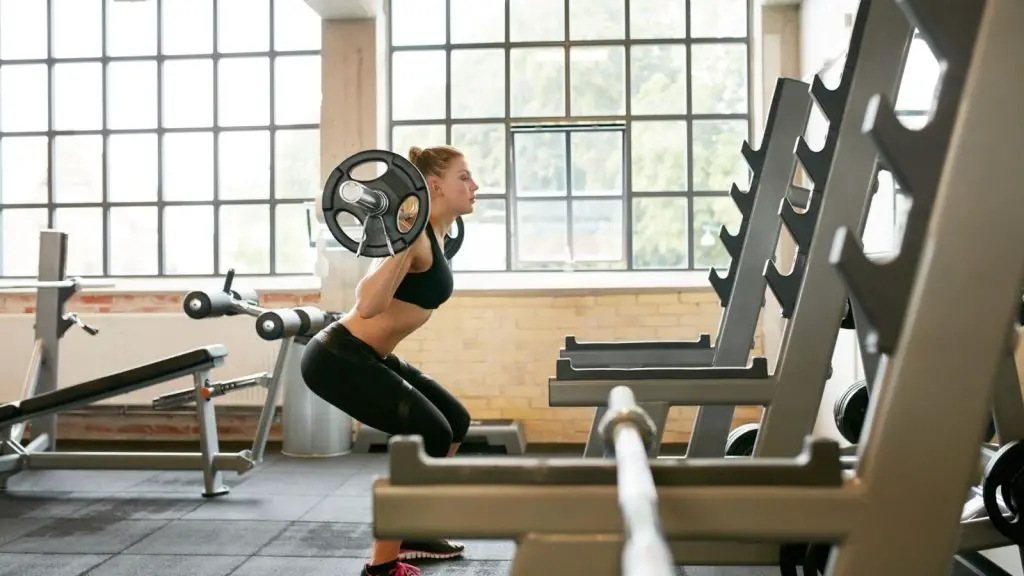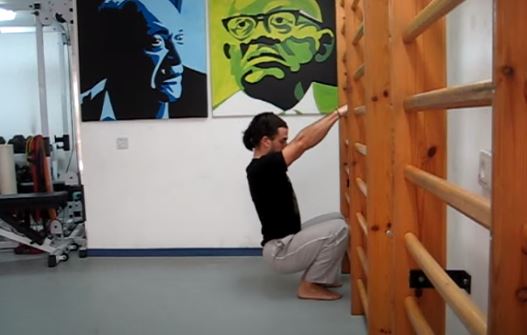I have see it numerous times over the like 20+ years with people struggling to keep their balance while squatting. I could be just using the Olympic bar with no extra added weight so there is absolutely nothing to be embarrassed about here. People fall back, lean forward, arch their back among other things which can eventually lead to injury. But when first starting out just start out with light weight or even no weight like using a broomstick works great.

So why do I fall back when I squat?
Falling back when squatting is caused by your hips moving back as you squat down this means you need extra mobility to stay balanced. Below are a few different reasons you may be falling back which include:
- Taller – meaning you have more disportionate weight will need to work on ankle flexibility
- Ankle Mobility – ankles are stiff they will cause your body to fall backward
- Stiff Calves – your calves if stiff will pull you backward
The good news is there are ways to correct this. Work on getting your self tight meaning flex your entire body this is a fight against gravity when you are squatting. Yes I know your calves and ankles need to be flexible at the same time. This is why you need to practice with bodyweight first using something like a broom stick. Below are some examples and opinions of real lifters as well to help you straighten up your squat.
Can't Do A Squat Without Falling Backwards
We didn't want you to only take our word on it on why you fall back in your squat and how to fix it. So we scoured the internet including forums and facebook groups to get feedback from real lifter who have had or helped people with the same issue. This is a very common issue as we previously stated. This was curated so the only thing changed was the spelling or grammar where needed.
Real Lifter Opinions
1. LostBeyondBelief “Deep bodyweight squats” – I think working toward a third world squat would really help you out. Basically, it's a bodyweight squat where you go all the way down until your hamstrings touch your calves and your weight is resting on your heels. You won't have the flexibility for it now, but once you get comfortable holding the position, you'll have the ankle, knee, and hip flexibility to perform just about any barbell exercise.
2. ShineeChicken “Improve your flexibility” –
In addition to all the suggestions wrt to improving flexibilty, here are some other things to try:
-
look at what you ~know is proper form, and then look again. Do a Google image search on proper squat form. You're going to see people with their back almost completely perpendicular to the floor, and you're going to people with a lot of forward lean. There will be people squatting with their feet shoulder-width apart, others with their feet a good deal wider than their shoulders; feet pointing forward, feet pointing out a little, feet pointing out a lot, knees staying behind toes, knees bending a bit PAST the toes, high bar, low bar…you get the point. There is no One squat position to rule them all. Proper form is a range that depends on your unique body, and the squat especially encompasses a great deal of variation. Try out a bunch of different positions, find the one that seems most natural even with your limited mobility, and stick with that while you try to improve your flexibility.
-
Pause squats. Once you've found a form that suits you, try elevator or pause squats at bodyweight or with light weight on the bar. Slowly go down, pause at the bottom. Raise yourself halfway. Pause. Go back down and raise yourself three-quarters of the way to the top. Pause. Go back down, and raise yourself to full standing position. Repeat, repeat, repeat. This is an excellent way for you to familiarize yourself with what it feels like to be at each stage of the lift, and while you're in those pauses you can wiggle around/do some slight adjusting to see what position feels most natural. It'll also teach you what position is no bueno, as the pauses will quickly wear on joints and whatnot if they're in a position they really don't need to be in. Use pause squats in every warmup if needed to “remind” your body of what a squat is supposed to feel like.
-
Front squats! Use them. Love them. Progress with them so you can get gainz while you're still trying to figure out your back squat. Front squatting also strengthens your core and back, two areas of accessory strength which are essential to progressing with back squats. Front squats work the quads, yes, but focus on activating the glutes and you'll also be training them to fire during your back squats, where lack of glute activation can make even proper form feel unnatural.
-
Knees out. Knees out. Knees OUT. Long legs typically do better with feet pointed somewhere around 15-30 degrees out. Push your knees out to track with the toes. Cue yourself before every squat. You'd be amazed how easily you can forget to push out, even though it's often such an essential part of natural/proper form.
-
Look up a bit as you squat down. This helps prevent excessive forward lean. Keep your back TIGHT.
-
Depending on the position you decide works best for you, your method of descent will be different. There's a squat where you push your hips back (box squats, squat to parallel usually) and there's a squat where your cue is to sink your hips DOWN between your knees rather than pushing back (seen more with ATG squats).
-
Be smart. If a certain position is causing weird pain, don't do it.
-
Frequency. Practice, practice, practice. Do goblet squats for a warmup every time you workout. Your body's not used to squatting, and the best way to overcome that is to, you know…squat a lot.
T-Nation has a ton of amazing articles and videos about proper squat form. I highly recommend you take a look at their archives.
3. ThaDass “Fix your mobility issues”-
Fix your mobility issues. Something like Agile 8 or Limber 11 on a regular basis could provide some improvements in a month or so. Alan Thrall's How To Squat video also has some very useful information on squat flexibility and some ways to improve it.
I'm 6'4″ as well and know your flexibility/mobility woes. I took Jason Blaha's suggestion on doing an entire month of mobility work before starting his Novice program and it helped a ton.
4. StrongNanuk “Work On Flexility” –
As others have said, you need to work on your flexibility. I will touch on that in a moment, but what I would really like to share with you is what to do in your squats for the time-being, while you are not flexible. You can improve your form instantly.
Starting out with squats I had problems with forms that came down to flexibility. My hamstrings were the main problem. What I found helping immediately to improve my form was: putting weights or something else about an inch or two thick under the heels. This allows you to put your weight on your heels and go parallel, without requiring as much flexibility in the leg to do it. Also practice squatting in correct form without any weight. Wiggle your toes. If you can't wiggle your toes during any part of the movement, it's an instant way to know you are doing it wrong. Squat the lowest you can and wiggle your toes for confirmation (wiggling toes is how you know the weight is on your heels).
This will help instantly but temporarily. It will also increase flexibility on it's own. But you still need to work on flexibility and form or you won't be able to go up in weight without hurting yourself, and you are at greater risk of injury. Flexibility is needed particularly in the hamstrings and the hip flexors (look up stretches / stretch routines for these muscles) training to do the splits will target these muscle groups as well, so if you follow a youtube series on “getting your splits” it will help tremendously (even if you never get flexible enough to do those splits.) Having multiple goals with anything is helpful for tracking progress, however.
It's best to deeply stretch these muscle groups (15-20 minutes) out around four hours prior to doing your squats, but not right before as your muscles will lose power from stretching right before (you can stretch lightly though). You should also stretch after. Stretch as often as you can. Hold each stretch for 30-60 seconds, at least.
5. Brierrat “Imagine Belly Between Legs” – The cue that worked best for me was to imagine, at the bottom of the squat, that you are putting your belly between your legs. Prior to weight lifting, I almost never used my hip joint as an upper body hinge; instead, I'd round my lower back out if I needed to, say, reach for the floor. Part of learning both the deadlift and the squat was learning to use the hip joint as an upper body hinge
Results
Pretty much 100% of the opinions we went over (253 to be exact) stated to work on your flexibility. So how you go about that is going to come down to the work you are willing to put in. The key is to progress and take as slowly as you can. Start with bodyweight, work up to bar, then add weights to the bar.
Related Squat Questions
I can't Squat Without Lifting My Heels?
Having issues lifting your heels when squatting is quite normal you can counter this by working on your ankle flexibility. Squat while holding onto something sturdy like a chair so you can work on that flexibility and balance. Work on this everyday for 10-14 days to see a major improvement.

Why Can't I Keep My Balance When I Squat?
Squatting isn't natural as you are fighting gravity the whole way which makes for a great exercise, but your balance may need some work. Start with lighter weight until you are comfortable this may be with only your bodyweight using a broom. If that still isn't working hold onto something sturdy like a chair while you go deep into your squat. The deeper you can go with lighter weight the better you will be with balance once you add weight. Work on this for a few weeks to see major improvements.
Why do I have an urge to vomit after squats?
Feeling the urge to throw up after squatting is normal especially when you are lifting extremely heavy weights. This is your body's way of telling you, you are pushing the limits usually in a good way. Make sure you take in some water and calories when you feel better. Also make sure you are you breathing correctly when squatting as this can also make you feel sick if not. In through your nose and out through the mouth is usually the best way to get your air quality up. In and out through the nose is even better, but takes practice.

